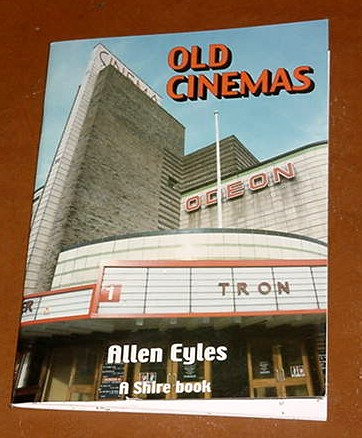|
|
This topic comprises 3 pages: 1 2 3
|
|
Author
|
Topic: How to efficiently twin a single screen?
|
Dan Chilton
Expert Film Handler
Posts: 191
From: Springfield, MO
Registered: Mar 2004
|
 posted 11-09-2005 03:50 PM
posted 11-09-2005 03:50 PM





I've seen several instances on this forum where someone is considering buying an old single-screen theater, and the most common piece of advice they get is: "twin it." I understand the concept, but I'm having a hard time visualizing how you'd split a single into a twin... or even a three screen.
Let's say, for instance, you have a grand old two story movie house with ~1,200 seats. As per usual with older theaters, the auditorium is wide in the back and tapers up towards the screen. Now, if you were to split it right up the middle, wouldn't you end up with two incredibly small screens? And probably lose a good percentage of seats to boot? Maybe I'm being too simple with the logistics, but how else would you do it?
PS - I'm not actually considering doing this... just genuinely curious.
| IP: Logged
|
|
|
|
Stephen Furley
Film God

Posts: 3059
From: Coulsdon, Croydon, England
Registered: May 2002
|
 posted 11-09-2005 04:54 PM
posted 11-09-2005 04:54 PM




It would depend on the design of the theatre. In my experience, dividing an auditorium that was not designed to be used that way is usually not ideal.
In this country the most common way do do it was to triple. basically, the circle (balcony) seating was left more or less as it was, with the original screen, and projection box. A wall was dropped from the front of the balcony into the stalls (whatever you call the downstairs seating area over there) area. This rear stalls area became two small auditoria, by building a dividing wall from front to back. This division was often unequal, to give three auditoria of different capacities. At the back of this area was built a new projection box for the two new screens, with entrances on either side of it into the new auditoria. These conversions were very common in the late '60s and '70s, they were often done quickly and cheaply, the screens in the new auditoria had to be small, the sightines were often poor, as were the accoustics. the height was restricted by the fact that everything was under the original balcony; this restricted both the height of the screen and the rake of the floor. The auditoria were odd shapes, access between the original and new projection boxes was often very inconvienient to say the least. In some cases there would be problems with things like emergency exits, and various odd arrangements could be found.
The original front salls area, in front of the new wall, was often just left as dead space, though in some cases the balcony was extended forwards. The loss of the front stalls area, and the space required for the new projection box tended to mean that the new auditoria were rather small. Most of these conversions have now closed, replaced by purpose-built multiplexes, though we still have quite a few of the older, 1910ish, smaller single screen cinemas operating.
If you want a multi-screen cinema you're usually better off designing one from scratch, rather than trying to convert an old single screen '30s one. It has to be said that most of these conversions were done when the need was to save money, and to do it quickly, or to close down. Given more time and money it can be done better, but the results are usually not ideal.
| IP: Logged
|
|
|
|
|
|
|
|
Jarryd Beard
Expert Film Handler

Posts: 229
From: Hellertown, PA
Registered: Jul 2004
|
 posted 11-09-2005 08:45 PM
posted 11-09-2005 08:45 PM




The theatre I work at was once a twin, now a 5-plex. Built around 1967, it originally had one auditorium 2/3 the width of the building and the other 1/3. Both were just as deep. The smaller theatre must have seemed awfully narrow. Now, each of the original auditoriums had their depth cut in about half to allow for auditoriums towards the back of the building. The result, only two descent sized houses. One auditorium, "The Screening Room" as I jokingly call it, has a smaller screen than some projection TVs I'm sure.
Cinemette made this change in the 80's consequently forcing the shutdown of two nice 1-screens in town. Around the same time, Cinemette halved a 1-screen into a twin. It's currently being restored, though I feel it's more of a remodeling. The theatre was originally built by Warner Bros. The "Theatre History" link on their website has some good info. See this link: The State Theatre
Eventually, our theatre (Cinema 5), the State, and The Movies (another single) were sold to Cinema World and then Carmike. Around 2001, The State and The Movies shut down due to Carmike's bankruptcy. The Movies was torn down this past summer to make room for a new apartment complex. Located a block away from the theatre I work at, we shared a projectionist between the two theatres Wed-Sun (union days).
| IP: Logged
|
|
|
|
David Campbell
Film Handler
Posts: 12
From: Gettysburg, PA, USA
Registered: Oct 2005
|
 posted 11-09-2005 10:33 PM
posted 11-09-2005 10:33 PM




The Majestic Theater here in Gettysburg, PA is just about done being restored and expanded into a performing arts center/cinema. The Grand Re-Opening is Monday, Nov. 14, 2005, the 80th anniversary of its opening night.
In the 1980s the company running it decided to turn the '20s Vaudeville movie house into a triple by putting a wall directly down the middle of the auditorium, an enclosed hallway down the right wall, and a wall closing off the proscenium. This created three cinemas, two in the main auditorium and one on the stage. Of course to make them wide enough, the curved walls leading to the stage and orchestra pit once holding organ pipes were torn down. They also took the opportunity to expand the lobby by adding a wall beneath the old balcony making room for a concession stand and small lobby.
Here's a link to the newly renovated Theater: Gettysburg Majestic
Dave
| IP: Logged
|
|
|
|
|
|
Stephen Furley
Film God

Posts: 3059
From: Coulsdon, Croydon, England
Registered: May 2002
|
 posted 11-10-2005 01:16 AM
posted 11-10-2005 01:16 AM




The Rity, Brixton was a typical early, c 1910 cinema. A few years ago four extra screens were added, by leaving he original almost as it was, the auditorium was shortened somewhat, to create additional foyer space, and a projection box of a more reasonable size, the 1910 ones were usually very small. Thw extra screens were added as modern new build on land alongside the original building, on which had previously been an annex, mainly storage space, to the local library. The facade of the original building was restored to its original appearance. Of course, this approach requires suitable land being available, and lots of money. To return to a point that I raised earlier, most of the original conversions were done on the cheap; there's a reason for that, they were loosing money, the owners were not in a position to spend lots of money in most cases.
There's a, rather small, picture here The new build can just bee seen to the right, the lower building which is white at the bottom, bot the brick building beyond. The decorative work above the roof line of the original building was removed at some time, and has been re-created. This is a very typical cinema building of this period; a lot of them were built in Britain around 1910, to comply with the requirments of the 1909 Cinematograph Act, which came into effect that year.
| IP: Logged
|
|
William Hooper
Phenomenal Film Handler
Posts: 1879
From: Mobile, AL USA
Registered: Jun 99
|
 posted 11-10-2005 03:25 AM
posted 11-10-2005 03:25 AM





You'd likely have better results seeing if there's some other space besides the auditorium that can be converted to a new auditorium: like attached streetfront commercial spaces, 2nd lobby on the side street, even the stage (if there is one).
Outside of the auditorium, the construction is pretty standard & most walls are partition walls, not load-bearing walls, that can be removed.
Height in these spaces may not be much of a problem, either. Usually in attached commercial spaces the partition walls span 2 or 3 columns supporting beams for the 1st & 2nd floors, & I've seen many theatres where the ceiling/floor between a unit of the 1st & 2nd floor commercial spaces has been removed to make a 2-story art gallery (or additional lobby space). You might not need to take the whole floor out either - you might just pull out enough for the back of the auditorium & projection booth, & slant the ceiling downwards to meet the existing ceiling (assuming it's got tall ceilings). Even on top floors, there's usually attic space where this can be done (& has been done for follow spots in black-box live theaters in converted non-theater buildings).
/----
--------/
(Not so extreme an angle on the ceiling, but you get the idea.)
Mr. UBB robot didn't like my ASCII art.
| IP: Logged
|
|
|
|
Stephen Furley
Film God

Posts: 3059
From: Coulsdon, Croydon, England
Registered: May 2002
|
 posted 11-10-2005 05:59 AM
posted 11-10-2005 05:59 AM




Allen has written a number of books on British cinema architecture, covering all of the major chains; the CTA (Cinema Theatre Association) has them listed on their web site here You could probably order them from overseas; contact them if you're interested.
Which Astoria was that? Old Kent Road was demolished, Streatham still exists, tripled as I described above, and then had two extra screens created, one of them on the former stage. It's Egyptian on the outside, nothing interesting on the inside, Brixton is now the 'Academy', a rock music venue, and Finsbury Park was also a music venue, but then the foyer became a church, and the auditorium was disused. I believe that the church later restored the main auditorium. In cinema days Brixton had almost level projection from a box under the balcony, but at Finsbury Park this wasn't allowed, so it had a ridiculous projection rake; the machines looked like they were pointing at the floor!
The CTA has made more than one visit to the USA, though I haven't been there with them. I used to be a member, but lapsed when my health deteriorated, and I couldn't go on visits. I keep meaning to re-join, but haven't got round to actually doing it.
quote: William Hooper
You'd likely have better results seeing if there's some other space besides the auditorium that can be converted to a new auditorium: like attached streetfront commercial spaces, 2nd lobby on the side street, even the stage (if there is one).
I've seen this done in a number of places; many of the big '30s cinemas had restraunts which were later converted to additional auditoria. In some places it is more successful than others, but a purpose-built auditorium usually works better than one converted from a space intended for some other use.
The City Screen, York, works quite well; this was created in a former newspaper building. web page
These sort of major alterations to the fabric of a building could be a problem if you're dealing with a listed building.
The ABC, Shaftsbury Avenue, was constructed as a twin, within the old Saville Theatre in London. The auditoria were constructed one above the other. I saw several 70mm shows there, 2001, Gettysburg, My Fair Lady. ABC went through several changes of owenership; shis place ended up as an Odeon, and I think it has been divided into more auditoria.
| IP: Logged
|
|
|
|
All times are Central (GMT -6:00)
|
This topic comprises 3 pages: 1 2 3
|
Powered by Infopop Corporation
UBB.classicTM
6.3.1.2
The Film-Tech Forums are designed for various members related to the cinema industry to express their opinions, viewpoints and testimonials on various products, services and events based upon speculation, personal knowledge and factual information through use, therefore all views represented here allow no liability upon the publishers of this web site and the owners of said views assume no liability for any ill will resulting from these postings. The posts made here are for educational as well as entertainment purposes and as such anyone viewing this portion of the website must accept these views as statements of the author of that opinion
and agrees to release the authors from any and all liability.
|

 Home
Home
 Products
Products
 Store
Store
 Forum
Forum
 Warehouse
Warehouse
 Contact Us
Contact Us




 Printer-friendly view of this topic
Printer-friendly view of this topic











![[Cool]](cool.gif)

![[thumbsdown]](graemlins/thumbsdown.gif)





